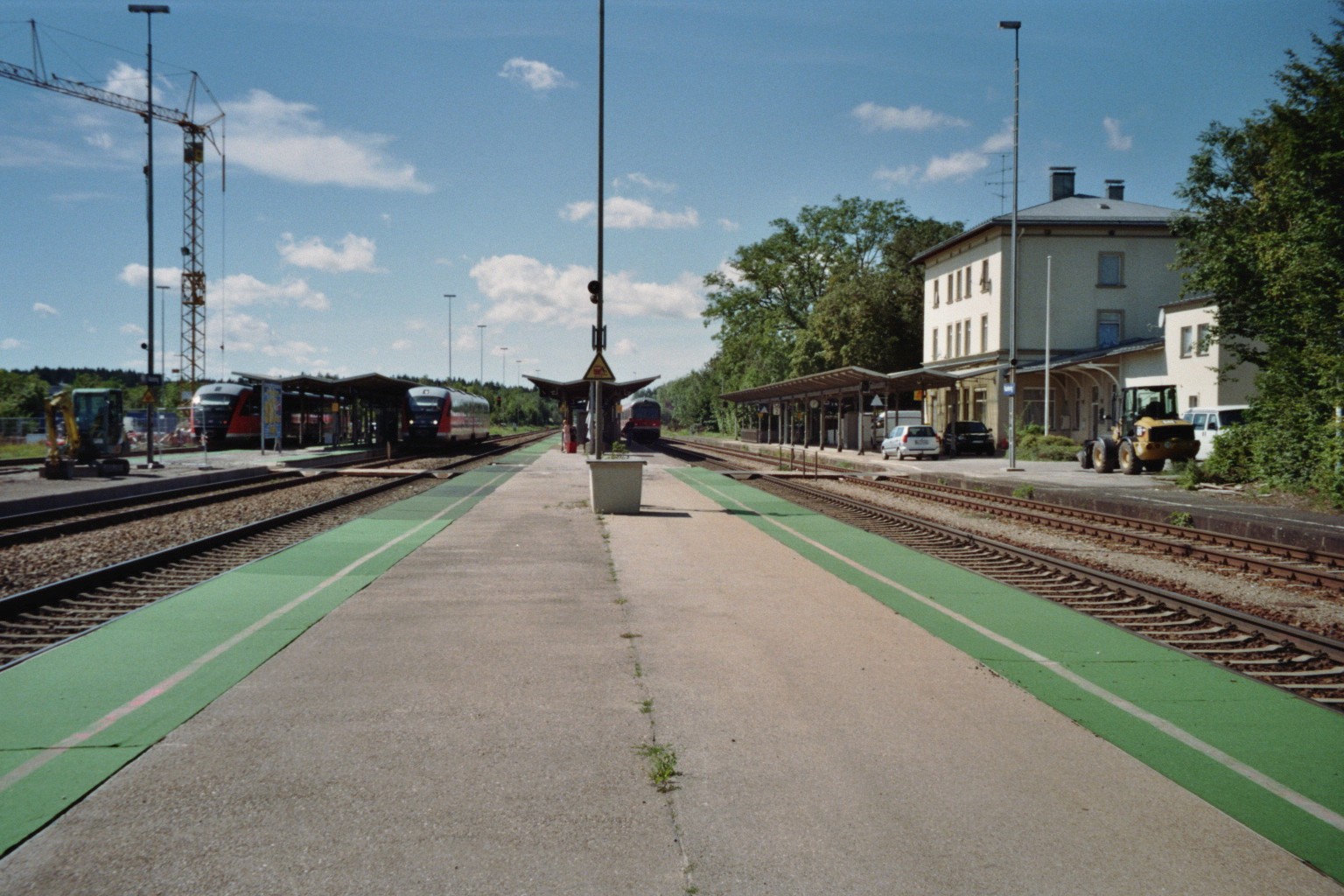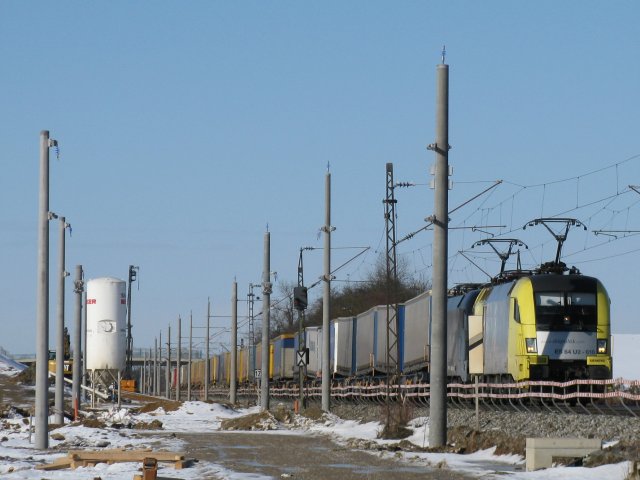|
Geltendorf Station
Geltendorf station is the largest railway station of the town of Geltendorf and is a railway junction in Upper Bavaria, Germany. The railway junction is also a station of the Munich S-Bahn. It has five platforms and is classified by Deutsche Bahn as a category 3 station. The station is served by about 150 trains daily of Deutsche Bahn, Bayerische Regiobahn (a subsidiary of Veolia Verkehr, BRB) and Regentalbahn, including 50 services of the Munich S-Bahn. The Munich–Buchloe railway and the Mering–Weilheim railway cross at the station. Geltendorf municipality also includes Walleshausen station and the disused stations of Kaltenberg and Wabern, all located on the Ammersee Railway. Location Geltendorf station lies south of the town centre in the south of the district of Geltendorf Bahnhof (Geltendorf station). The station building is located just north of the tracks and has the address of Am Bahnhof 6. The station is about a kilometre away from the town centre of Geltendorf. ... [...More Info...] [...Related Items...] OR: [Wikipedia] [Google] [Baidu] |
Münchner Verkehrs- Und Tarifverbund
The (MVV; Munich Transport and Tariff Association) is the transit authority of the city of Munich, the capital of the German state of Bavaria. Its jurisdiction covers the city and its surrounding area, responsible for the Munich S-Bahn commuter trains, the Munich U-Bahn, the Munich tramway and buses. The MVV coordinates transport and fares in area comprising the city of Munich and eight surrounding districts. It is jointly owned by the state of Bavaria, the city of Munich and the eight surrounding districts, which are: * Landkreis Bad Tölz-Wolfratshausen * Landkreis Dachau * Landkreis Ebersberg * Landkreis Erding * Landkreis Freising * Landkreis Fürstenfeldbruck * Landkreis München * Landkreis Starnberg Transport services are provided by over 40 companies. These include the Bayerische Oberlandbahn, the Deutsche Bahn The (; abbreviated as DB or DB AG) is the national railway company of Germany. Headquartered in the Bahntower in Berlin, it is a joint-stock company ( ... [...More Info...] [...Related Items...] OR: [Wikipedia] [Google] [Baidu] |
Kaufering Station
Kaufering station is the station of the market town of Kaufering in the Upper Bavarian district of Landsberg am Lech. The station has five platform tracks and is classified by Deutsche Bahn as a category 4 station. It is used daily by about 140 trains operated by DB Regio and Regentalbahn and is an interchange station between the Munich–Buchloe railway and the Bobingen–Landsberg am Lech railway (Lechfeld Railway). Location Kaufering station is located south of Kaufering. The station area is bounded to the north by Bahnhofstrasse and to the south by Viktor-Frankl-Straße. The station building is located north of the tracks and has the address of Bahnhofstrasse 15. History Kaufering station was opened on 1 November 1872 with the completion of the Buchloe–Kaufering– Landsberg railway. The line from Munich to Buchloe was opened on 1 May 1873. The Lechfeld Railway via Bobingen to Augsburg was opened on 15 May 1877. Kaufering was now a railway junction. On 5 April 1893, s ... [...More Info...] [...Related Items...] OR: [Wikipedia] [Google] [Baidu] |
EuroCity In Germany
The German rail network provides connections to each of its neighbouring countries, many of which are under the EuroCity classification. EuroCity services are part of the Intercity network - many EC services represented a couple of train pairs on an IC route extended across the border, while other routes are served primarily by EuroCity services. EuroCity services are generally locomotive-hauled, using Intercity rolling stock, either from Deutsche Bahn or one of the other countries along the route. EuroCity services Below is a list of current EuroCity services in Germany. † Name no longer in use. Intercity services that cross borders A number of trains provide international connections, but are classed as Intercity rather than Eurocity. This may be because the routes were former InterRegio services, or they only travel a short distance over the border. ICE international The ICE network has grown since its introduction, and there are now services to Aarhus, Amsterdam, ... [...More Info...] [...Related Items...] OR: [Wikipedia] [Google] [Baidu] |
Platform Display
A platform display, destination display or train describer (British English) is supplementing the destination sign on arriving trains giving passengers an advance information. Historically they did only show the next destination and sometimes the type of train. In later usage they were replaced by passenger information display systems (PIDS) allowing for real-time passenger information. The first railway stations had only a time table for passenger information. On larger stations the train porters would help passengers to board the correct train matching with their ticket. They were supervised by a station manager that would handle the security requirements for each departing train. The first help in that task was a bell to remind passengers to board the train in time which on smaller stations does also announce the next train. Different directions would then be called out on the platform. At the time that trains grew into mass transport systems this was not enough anymore. The t ... [...More Info...] [...Related Items...] OR: [Wikipedia] [Google] [Baidu] |
Bahnhof Geltendorf - Bayerische Regiobahn
Bahnhof (German for "railway station") is a Swedish Internet service provider (ISP) founded in 1994 by Oscar Swartz in Uppsala, Sweden, and is the country's first independent ISP. Today the company is represented in Stockholm, Gothenburg, Uppsala, Borlänge, Malmö and Umeå. WikiLeaks used to be hosted in a Bahnhof data center inside the ultra-secure bunker Pionen, which is buried inside the White Mountains in Stockholm. History Bahnhof was founded in 1994 by Oscar Swartz. It was one of Sweden's first ISPs. The company is publicly traded since December 2007 under the name BAHN-B (Aktietorget). On 11 September 2008, Bahnhof opened a new computer center inside the former civil defence center Pionen in the White Mountains in Stockholm, Sweden. Controversies On 10 March 2005, the Swedish police confiscated four servers placed in the Bahnhof premises, hoping to find copyrighted material. Although these servers were located near Bahnhof's server park (in a network lab area) ... [...More Info...] [...Related Items...] OR: [Wikipedia] [Google] [Baidu] |
Bahnhof Geltendorf Bahnsteige2
Bahnhof (German for "railway station") is a Swedish Internet service provider (ISP) founded in 1994 by Oscar Swartz in Uppsala, Sweden, and is the country's first independent ISP. Today the company is represented in Stockholm, Gothenburg, Uppsala, Borlänge, Malmö and Umeå. WikiLeaks used to be hosted in a Bahnhof data center inside the ultra-secure bunker Pionen, which is buried inside the White Mountains in Stockholm. History Bahnhof was founded in 1994 by Oscar Swartz. It was one of Sweden's first ISPs. The company is publicly traded since December 2007 under the name BAHN-B (Aktietorget). On 11 September 2008, Bahnhof opened a new computer center inside the former civil defence center Pionen in the White Mountains in Stockholm, Sweden. Controversies On 10 March 2005, the Swedish police confiscated four servers placed in the Bahnhof premises, hoping to find copyrighted material. Although these servers were located near Bahnhof's server park (in a network lab area) ... [...More Info...] [...Related Items...] OR: [Wikipedia] [Google] [Baidu] |
Bahnbetriebswerk (steam Locomotives)
A ''Bahnbetriebswerk'' (also abbreviated to ''Betriebswerk'', ''Bw'' or ''BW'') is a German railway depot where the maintenance of locomotives and other rolling stock is carried out. It is roughly equivalent to a locomotive shed, running shed or motive power depot. These were of great importance during the steam locomotive era to ensure the smooth running of locomotive-hauled services. ''Bahnbetriebswerke'' had a large number of facilities in order to be able to carry out their various maintenance tasks. As a result, they needed a lot of staff and were often the largest employers in the area. ''The history and present-day importance of such depots is covered in the ''Bahnbetriebswerk'' article.'' __TOC__ Functions Preparation of engines Before a steam locomotive was allowed onto the line, the crew had to carry out a large number of preparatory jobs. In accordance with the enginemen roster, the locomotive crew – engine driver and fireman – reported to the running forema ... [...More Info...] [...Related Items...] OR: [Wikipedia] [Google] [Baidu] |
DB Class 628
The DB Class 628 is a twin-car, diesel multiple unit operated by the Deutsche Bahn for local passenger rail services. Design ''(The following description is primarily related to the Class 628.4, and is largely valid for the other variants as well)'' Each coach rests on two twin-axle bogies. Only the bogie at the close-coupled end of the coach is driven. Power transmission from the motor is achieved using a ''Voith'' hydrodynamic transmission system with a converter (''Wandler'') and a T 311r coupling. Up to Class 628, a T 320 double-converter transmission was used. Motor and transmission are suspended elastically under the lightweight coach body. The operating brake is an automatic compressed air KE disc brake with automatic load braking and electronic anti-skid protection. In addition, for rapid braking, electromagnetic rail brakes are used; these can also be activated separately if required. Coupled running enables up to four coupled pairs of coaches to be driven from one ... [...More Info...] [...Related Items...] OR: [Wikipedia] [Google] [Baidu] |
Munich–Augsburg Railway
The Munich–Augsburg line connects Munich and Augsburg in the German state of Bavaria. It was built by the Munich-Augsburg Railway Company and opened in 1840. It was nationalised in 1846 and extended to Ulm in 1854. The line between Augsburg and Munich is a major traffic axis and part of the Magistrale for Europe from Budapest through Vienna to Paris. History The line was built by the Munich-Augsburg Railway Company (German: ''München-Augsburg Eisenbahn-Gesellschaft'') and opened in 1839 and 1840. The Munich-Augsburg Railway Company was nationalised on 1 June 1846 and taken over by the Royal Bavarian State Railways (''Königlich Bayerische Staats-Eisenbahnen''). The line became part of Bavarian Maximilian’s Railway (''Bayerische Maximiliansbahn'') and was extended to Ulm on 1 May 1854. After the nationalisation of the line in 1846 a new Augsburg station was built at Rosenauberg along with new rail facilities in nearby Oberhausen. The old stations at the ''Roten Tor'' ... [...More Info...] [...Related Items...] OR: [Wikipedia] [Google] [Baidu] |
Buchloe Station
Buchloe station is the only station in the town of Buchloe in the German state of Bavaria. It is at the junction of the Augsburg–Buchloe and Buchloe–Memmingen, Munich–Buchloe and the Buchloe–Lindau railways. History Buchloe station was established with the Augsburg–Kaufbeuren railway, which opened on 1 September 1847. The station building was completed a year later on 15 October 1848. The station at that time was about a kilometre from the town of Buchloe. The town then had about 850 inhabitants and was selected as one of eleven waterering points and stations for handling fast freight between Augsburg and Lindau. A loading dock in the loading shed for three wagons and a cattle ramp were built after the construction of the station building. Similarly, there was a 35-metre long carriage shed, where minor repairs could be made. A few years later, many houses were built along Bahnhofstrasse (station street). Business increased with the construction of the Munich–Memmin ... [...More Info...] [...Related Items...] OR: [Wikipedia] [Google] [Baidu] |
Relay Interlocking
In railway signalling, an interlocking is an arrangement of signal apparatus that prevents conflicting movements through an arrangement of tracks such as junctions or crossings. The signalling appliances and tracks are sometimes collectively referred to as an ''interlocking plant''. An interlocking is designed so that it is impossible to display a signal to proceed unless the route to be used is proven safe. Interlocking is a safety measure designed to prevent signals and points/switches from being changed in an improper sequence. For example interlocking would prevent a signal from being changed to indicate a diverging route, unless the corresponding points/switches had been changed first. In North America, the official railroad definition of interlocking is: "''An arrangement of signals and signal appliances so interconnected that their movements must succeed each other in proper sequence''". Configuration and use A minimal interlocking consists of signals, but usually ... [...More Info...] [...Related Items...] OR: [Wikipedia] [Google] [Baidu] |
Weilheim In Oberbayern
Weilheim in Oberbayern (English: 'Weilheim in Upper Bavaria') is a town in Germany, the capital of the district Weilheim-Schongau in the south of Bavaria. Weilheim has an old city-wall, historic houses and a museum. Local history Up to the 18th century The oldest traces of human settlement date back to the Bronze AgeBernhard Wöll (Stadtarchiv Weilheim i. OB): ''Jubiläums-Chronik'' der Stadt Weilheim, anlässlich der 1000-jährigen erstmaligen urkundlichen Erwähnung im Jahr 1010 von Weilheim und Polling, Herausgeber: Stadt Weilheim i. OB 2010. and there were grave finds from the Late Roman era. The name Weilheim is interpreted as a home to the Roman villas (land estates). There are, however, several other theories for the roots of the name. Upper Bavaria came in Roman hands through commander Drusus.Sonderbeilage des Weilheimer Tagblattes anlässlich der 1000-jährigen erstmaligen urkundlichen Erwähnung der Orte Polling und Weilheim 16 April 2010, page 4. The Romans built "V ... [...More Info...] [...Related Items...] OR: [Wikipedia] [Google] [Baidu] |



.jpg)



